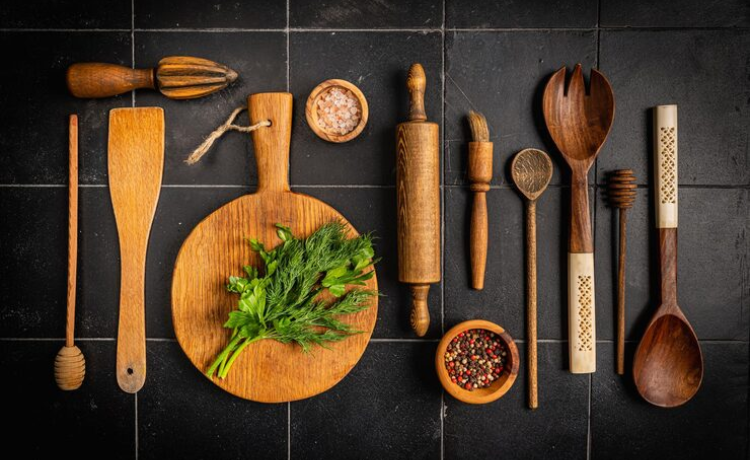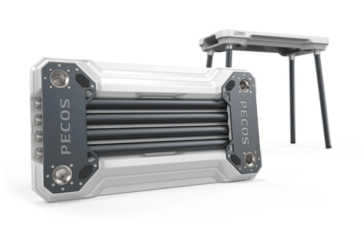Selecting the best wood for kitchen utensils affects more than just aesthetics. The wood you choose impacts durability, food safety, and your cooking experience. Professional chefs and home cooks alike understand that quality wooden utensils can last decades when crafted from the proper materials.
Wood selection matters because different species offer varying levels of hardness, porosity, and natural antimicrobial properties. Some woods contain toxic compounds that can leach into food, while others provide natural resistance to bacteria and moisture. Understanding these differences helps you make informed decisions that protect your family’s health while investing in tools that perform reliably.
The environmental impact of your choice also deserves consideration. Sustainable wood options support responsible forestry practices and reduce your kitchen’s carbon footprint. Whether you prioritize durability, sustainability, or aesthetic appeal, this guide will help you navigate the options and select the best wood for your specific needs.
Top 5 Types of Best Wood for Kitchen Utensils
Professional kitchens and discerning home cooks consistently favor five wood types for their exceptional properties and proven performance in food preparation environments.
Maple: The Classic Choice for Durability
Maple stands as the gold standard for kitchen utensils due to its exceptional hardness and closed grain structure. This dense hardwood resists bacteria penetration and maintains its integrity through years of daily use. Maple wood utensils demonstrate remarkable stain resistance, making them ideal for tasks involving colorful ingredients like tomato sauce or turmeric.
The non-porous nature of maple makes it particularly suitable for cutting boards, wooden spoons, and spatulas. Professional chefs appreciate maple’s ability to withstand heavy-duty stirring and mixing without splintering or showing wear. Sugar maple, specifically, offers the highest density and most consistent grain pattern among maple varieties.
Maple’s neutral flavor profile ensures it won’t impart unwanted tastes to delicate dishes. This characteristic makes maple wood cooking spoons perfect for sauces, custards, and other flavor-sensitive preparations where taste purity matters most.
Cherry: Beautiful and Sturdy
Cherry wood combines aesthetic appeal with practical durability, making it a favorite for both functional and decorative kitchen pieces. This hardwood naturally darkens with age, developing a rich patina that enhances its visual appeal over time. Cherry’s tight grain structure provides excellent resistance to scratches and dents.
The natural beauty of cherry wood makes it ideal for serving pieces like salad spoons and stirring paddles that transition from cooking to presentation. Cherry wood kitchen tools maintain their smooth finish longer than softer woods, reducing the need for frequent refinishing.
Cherry’s moderate weight provides comfortable handling during extended cooking sessions. The wood’s stability prevents warping and cracking under normal kitchen conditions, making cherry wood utensils reliable investments for serious cooks.
Walnut: The Premium Wood for Kitchen Utensils
Walnut represents the luxury tier of kitchen wood choices, prized by professional chefs for its exceptional strength and striking appearance. This premium hardwood offers superior durability for heavy-duty applications while maintaining an elegant grain pattern that adds sophistication to any kitchen.
The density of walnut makes it ideal for high-end spatulas and ladles that must withstand rigorous commercial kitchen demands. Walnut wood utensils resist splitting and maintain their shape even under extreme stress, making them worthwhile investments for serious culinary enthusiasts.
Walnut’s natural oils provide inherent moisture resistance, reducing the maintenance requirements compared to drier hardwoods. The rich chocolate tones of walnut create striking contrast against light-colored foods, making these luxury kitchen tools perfect for presentation as well as preparation.
Bamboo: The Eco-Friendly Alternative
Bamboo technically qualifies as grass rather than wood, but its exceptional properties make it increasingly popular for sustainable kitchen utensils. This renewable resource grows exponentially faster than traditional hardwoods, reaching harvest maturity in just three to five years compared to decades for trees.
Bamboo kitchen utensils offer natural antimicrobial properties that inhibit bacterial growth without chemical treatments. The lightweight nature of bamboo makes it comfortable for extended use while maintaining sufficient strength for most cooking tasks. Bamboo stirring spoons and tongs perform admirably for everyday cooking needs.
The sustainability benefits of bamboo appeal to environmentally conscious consumers seeking to reduce their ecological footprint. Bamboo’s rapid regeneration and minimal processing requirements make it one of the most eco-friendly options for conscious kitchen tool selection.
Teak: The Tropical Wonder Wood
Teak’s exceptional water resistance makes it uniquely suited for kitchen environments with high humidity or frequent moisture exposure. This tropical hardwood contains natural oils that repel water and resist bacterial growth, making teak wood utensils practically maintenance-free.
The natural oiliness of teak eliminates the need for frequent conditioning treatments required by other hardwoods. Teak serving spoons and salad bowls maintain their appearance and functionality with minimal care, making them ideal for busy kitchens or outdoor cooking applications.
Teak’s stability in varying moisture conditions prevents the expansion and contraction that can damage other wood types. This water-resistant kitchen wood performs consistently whether used in humid summer kitchens or dry winter environments.
What Makes a Wood Safe for Kitchen Use?
Food safety represents the paramount concern when selecting wood for kitchen utensils. Safe kitchen wood must meet specific criteria regarding toxicity, porosity, and bacterial resistance to ensure it won’t compromise food quality or health.
The porosity of wood directly affects its ability to harbor bacteria and resist staining. Dense, closed-grain woods prevent bacterial penetration and facilitate thorough cleaning. Open-grain woods, while beautiful, create crevices where bacteria can multiply and become difficult to eliminate through normal washing.
Chemical composition varies significantly among wood species. Some trees produce natural compounds that protect against insects and decay but can transfer harmful substances to food. Understanding which woods contain no toxic elements ensures your utensil choices support rather than compromise kitchen safety.
Non-Toxic Woods for Utensils
Several hardwood species demonstrate proven safety records for food contact applications. Maple, cherry, and walnut contain no known toxic compounds that could leach into food during normal use. These non-toxic kitchen utensils provide peace of mind for health-conscious cooks.
Avoid woods like cedar, pine, or other softwoods that contain aromatic oils potentially harmful to human health. Additionally, exotic woods often used in decorative applications may contain unknown compounds that haven’t been thoroughly tested for food safety.
Always verify that wooden utensils haven’t been treated with stains, lacquers, or other chemical finishes that could contaminate food. Safe wood for cooking tools should feature only food-grade finishes or remain completely unfinished.
How to Maintain Food Safety with Wooden Utensils
Proper maintenance ensures wooden utensils remain safe throughout their service life. Regular cleaning with hot, soapy water removes surface contaminants and prevents bacterial accumulation. Thorough drying after each use prevents moisture retention that could encourage microbial growth.
Monthly oiling with food-grade mineral oil or specialized wood conditioners maintains the wood’s integrity and enhances its natural antimicrobial properties. This maintenance routine preserves the closed-grain structure that prevents bacterial penetration.
Replace wooden utensils that develop deep cracks, permanent stains, or persistent odors. These signs indicate the wood’s protective properties have been compromised, potentially creating food safety risks.
Durability: Which Woods Last the Longest?
Durability depends on wood density, grain structure, and natural resistance to wear. The longest-lasting wooden utensils come from hardwoods with tight grain patterns and high density ratings. These characteristics ensure the tools maintain their shape and functionality through years of regular use.
Maple and walnut consistently demonstrate superior longevity in professional kitchen environments. Their exceptional hardness resists denting and scratching while maintaining smooth surfaces that remain comfortable to use. These durable kitchen woods justify higher initial costs through extended service life.
Wood density measurements provide objective comparisons between species. Maple averages 44 pounds per cubic foot, while softer woods like pine measure only 25 pounds per cubic foot. This density difference directly correlates with durability and resistance to damage.
Best Woods for Heavy-Duty Use
Commercial kitchens demand utensils capable of withstanding intensive daily use without failure. Heavy-duty kitchen utensils made from maple or walnut handle the rigorous demands of professional cooking environments. These woods maintain their integrity even when subjected to constant stirring, scraping, and cleaning.
Hardwood cutting boards crafted from end-grain maple or walnut can serve professional kitchens for decades with proper maintenance. The self-healing properties of end-grain construction allow knife marks to close naturally, extending the board’s useful life significantly.
Durable wooden spoons made from dense hardwoods resist the splintering and cracking that plague cheaper alternatives. Investing in quality heavy-duty utensils eliminates the need for frequent replacement while ensuring consistent performance.
The Environmental Impact of Choosing the Right Wood
Sustainable kitchen choices extend beyond functionality to consider environmental responsibility. Wood selection affects forest health, carbon sequestration, and manufacturing energy consumption. Conscious consumers can minimize their ecological footprint through informed wood utensil choices.
Traditional hardwood harvesting requires decades for forest regeneration, making sustainability a long-term consideration. However, responsibly managed forests provide renewable resources while maintaining ecological balance. Choosing certified sustainable options supports responsible forestry practices.
Transportation distances also impact environmental footprint. Locally sourced woods reduce shipping emissions while supporting regional economies. Research the origin of your kitchen utensils to make environmentally informed decisions.
Bamboo: A Renewable Resource
Bamboo’s remarkable growth rate makes it the most sustainable option for eco-conscious kitchens. Some bamboo species grow up to 35 inches in a single day, reaching harvest size within three years. This rapid renewable cycle provides abundant material without depleting natural resources.
Bamboo cultivation requires no replanting after harvest since the root system continues producing new shoots indefinitely. This sustainable characteristic eliminates the environmental costs associated with replanting and establishing new forests.
The carbon sequestration capacity of bamboo exceeds that of many hardwood trees, making bamboo kitchen utensils actively beneficial for atmospheric carbon reduction. Bamboo sustainability extends beyond renewable harvesting to include positive environmental impact.
Choosing FSC-Certified Wood
Forest Stewardship Council certification ensures wood products come from responsibly managed forests that maintain biodiversity and support local communities. FSC-certified wood for utensils provides assurance that your purchase supports sustainable forestry practices.
Certified sustainable options include maple, cherry, and walnut from managed forests that balance harvesting with regeneration. These programs ensure future generations will have access to these valuable hardwood resources while protecting forest ecosystems.
Look for FSC certification labels when purchasing wooden kitchen utensils. This certification system provides third-party verification of sustainable harvesting practices and environmental responsibility.
How to Care for Your Wooden Kitchen Utensils
Proper maintenance extends the life of wooden kitchen utensils while preserving their safety and functionality. Regular care prevents cracking, staining, and bacterial growth that can compromise both performance and food safety.
Temperature extremes pose the greatest threat to wooden utensils. Avoid dishwasher cleaning and extended soaking, which can cause splitting and warping. Similarly, never place wooden utensils near heat sources or in direct sunlight for extended periods.
Maintaining wooden utensils requires minimal effort but consistent attention. Establishing regular cleaning and conditioning routines ensures these valuable kitchen tools provide decades of reliable service.
Cleaning and Oiling Wooden Utensils
Hand washing with warm, soapy water provides the safest and most effective cleaning method for wooden utensils. Gentle scrubbing removes food particles and surface bacteria without damaging the wood’s protective finish. Thorough rinsing eliminates soap residue that could affect food flavor.
Air drying prevents the cracking and warping associated with heat exposure. Allow utensils to dry completely before storage to prevent moisture retention that encourages bacterial growth. Proper drying typically requires several hours in a well-ventilated area.
Monthly conditioning with food-grade mineral oil maintains the wood’s moisture content and enhances its natural antimicrobial properties. Apply oil with a clean cloth, allow penetration for several hours, then buff away excess. This oiling wooden spoons process preserves their appearance and functionality.
Storing and Protecting Your Wooden Utensils
Proper storage prevents damage and extends utensil life. Store wooden utensils in dry, well-ventilated areas away from heat sources and direct sunlight. Avoid sealed containers that trap moisture and promote mold growth.
Drawer storage works well for most wooden utensils when protected by dividers or organizers that prevent scratching. Standing storage in ceramic crocks provides excellent ventilation while keeping utensils easily accessible during cooking.
Protect wooden utensils from impact damage by avoiding overcrowded storage areas. Individual protection for valuable pieces prevents nicks and scratches that can compromise the wood’s integrity and harbor bacteria.
Also Read: “outdoor kitchen sink“
Finding the Perfect Wood for Your Kitchen
Selecting the best wood for kitchen utensils requires balancing durability, safety, sustainability, and aesthetic preferences. Professional recommendations consistently favor maple for its exceptional properties, while cherry and walnut provide premium alternatives with distinctive visual appeal.
Consider your specific cooking style and requirements when making selections. Heavy-duty cooking demands the superior durability of maple or walnut, while occasional use might justify the sustainability benefits of bamboo. Match wood properties to intended applications for optimal performance and satisfaction.
Investment in quality wooden utensils provides long-term value through extended service life and superior performance. Choose established manufacturers who understand wood properties and construction techniques that maximize durability and safety.
The environmental impact of your choices extends beyond personal benefits to global sustainability. Supporting responsible forestry practices and renewable resources through informed purchasing decisions contributes to environmental conservation while equipping your kitchen with exceptional tools.
Quality wooden kitchen utensils represent investments in cooking performance, food safety, and environmental responsibility. Choose wisely among the proven options of maple, cherry, walnut, bamboo, or teak based on your priorities and requirements for optimal satisfaction and performance.
Frequently Asked Questions
What is the best wood for making cooking spoons?
Maple consistently ranks as the best wood for cooking spoons due to its exceptional durability, non-porous grain structure, and neutral flavor profile. Professional chefs prefer maple because it resists staining, doesn’t impart flavors to food, and maintains its integrity through years of heavy use. The closed grain prevents bacteria penetration while the hardness resists denting and scratching. Sugar maple specifically offers the highest density and most consistent performance for cooking spoon applications.
How do I know if my wooden utensils are food-safe?
Food-safe wooden utensils should be made from non-toxic hardwoods like maple, cherry, or walnut without chemical treatments or finishes. Verify that utensils haven’t been stained, lacquered, or treated with any non-food-grade substances. Safe utensils will have smooth surfaces without cracks or deep scratches that could harbor bacteria. Avoid softwoods like pine or cedar, and exotic woods with unknown toxicity levels. If utensils develop persistent odors, deep stains, or visible damage, replace them immediately to maintain food safety.
Can I use olive oil to maintain my wooden utensils?
While olive oil is food-safe, it’s not ideal for maintaining wooden utensils because it can become rancid over time, creating unpleasant odors and potentially harmful compounds. Food-grade mineral oil provides the best option for wooden utensil maintenance because it doesn’t spoil, penetrates wood effectively, and creates a protective barrier against moisture and bacteria. Apply mineral oil monthly using a clean cloth, allow penetration for several hours, then buff away excess for optimal protection and longevity.
Which wood is the most eco-friendly for kitchen tools?
Bamboo represents the most eco-friendly option for kitchen tools due to its rapid growth rate and renewable harvesting properties. Bamboo reaches maturity in just three to five years compared to decades for traditional hardwoods, and it regenerates from existing root systems without replanting. For traditional woods, look for FSC-certified maple, cherry, or walnut from sustainably managed forests. Local sourcing also reduces transportation environmental impact while supporting regional forestry operations.
How often should I replace my wooden kitchen utensils?
Well-maintained wooden utensils made from quality hardwoods can last 10-20 years or more with proper care. Replace utensils when they develop deep cracks, persistent stains, permanent odors, or rough surfaces that could harbor bacteria. Signs requiring immediate replacement include splitting, warping, or any structural damage that affects functionality. Regular monthly conditioning with food-grade mineral oil and proper cleaning techniques significantly extend utensil lifespan while maintaining safety and performance.
Are bamboo kitchen utensils as durable as hardwood options?
Bamboo kitchen utensils offer good durability for light to moderate use but don’t match the longevity of dense hardwoods like maple or walnut. Bamboo works well for stirring, serving, and general cooking tasks but may show wear more quickly under heavy-duty use. However, bamboo’s sustainability benefits and natural antimicrobial properties make it an excellent choice for environmentally conscious cooks willing to replace utensils more frequently. For maximum durability, choose bamboo utensils with thicker construction and quality manufacturing.
What’s the difference between end-grain and edge-grain cutting boards?
End-grain cutting boards expose the cut ends of wood fibers, creating a surface that allows knife blades to slip between fibers rather than cutting across them. This construction provides superior knife protection and self-healing properties as fibers close after cutting. Edge-grain boards show the side of wood fibers and offer good durability at lower cost but don’t provide the knife-friendly characteristics of end-grain construction. End-grain boards typically last longer and maintain their appearance better but require more initial investment.
Can I put wooden utensils in the dishwasher?
Never put wooden utensils in the dishwasher as the high temperatures and harsh detergents can cause cracking, warping, and finish damage. The intense heat and prolonged water exposure strip natural oils from wood, leading to splitting and reduced lifespan. Hand washing with warm soapy water followed by thorough air drying provides the safest cleaning method that preserves wood integrity and extends utensil life. This gentle approach maintains the natural antimicrobial properties and protective finish of quality wooden utensils.












